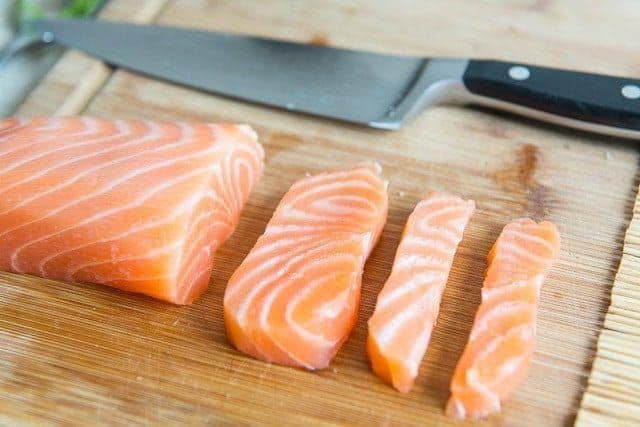Unless you don’t recognize your sushi master, you simply don’t know 100 percent how to cut salmon for sushi and others, just markedly different sushi slices. To not be scared, we have assembled this thorough step by step set of directions to guide you. It is really very easy to learn, in principle, but it does require plenty of action and a nice sushi knife or yanagiba to perfect cuts and just not lose any salmon.
Sushi is one of the most common and popular traditional Japanese foods. Sushi is typically served with mostly soy sauce. A selection of meats may be eaten in sushi format. Chicken, deer, beef, and skin of tofu! Seafood sushi or nigiri, however, is the most common choice, especially salmon.
But why salmon first? Since salmon is full of beneficial effects! Salmon is also known in Japan as sake, and is a good quality fish. It has large levels of Omega-3 fats, selenium, plenty of vitamin D and even other vitamins.
In fact Salmon is key among almost all sushi restaurants Chefs and clients really like sake sashimi, mostly toro-salmon. This is the fatty and tasty aspect of the food. So let’s offer you some skills for a sushi time to please your mates. Below is how to cut salmon for a sushi type of tuna!
The technique of salmon cutting has various forms and techniques. You could made the yummy salmon sushi according to your choice along with one of the following methods:
- How To Choose A Good Quality Salmon?
- How To Prepare Tools And Kitchen Space
- How To Filleting The Salmon Whole
- How To Cut Salmon For Sushi Step By Step
- How To Make Salmon Sushi
- What Are The Health Benefits Of Salmon
- Q&A Part
- Conclusion
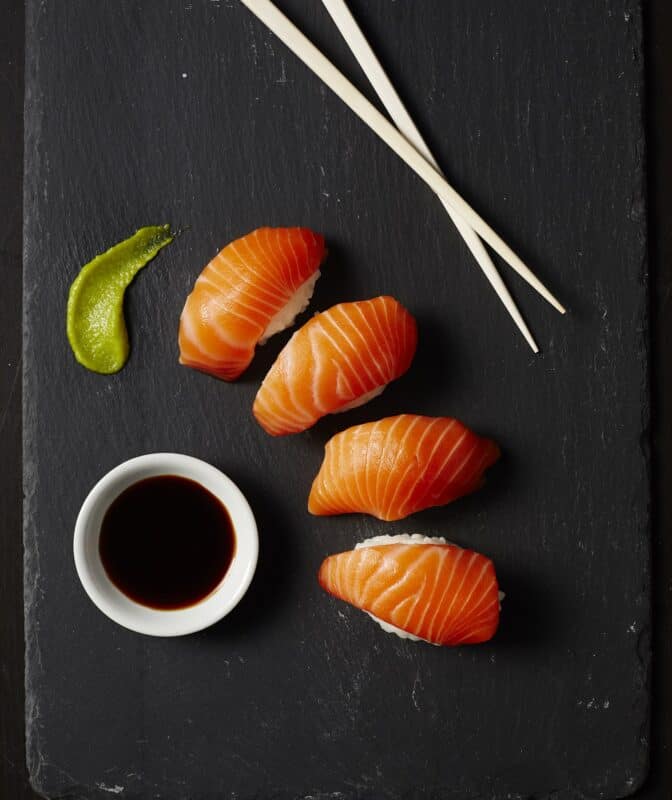
Table of Contents
How To Choose A Good Quality Salmon?
No products found.
The most significant step is to select good quality fresh fish.
Salmon is among the most commonly eaten fish on the market or can be picked wild and farmed. But you can’t only use raw salmon because this species is unusually vulnerable to parasites which really cause foodborne disease related to raw fish eating. You must seek sushi grade fish, which shows that you are good to eat in their natural state. Because it means that the salmon has been quickly caught, bled after it is caught, rustled at that moment and even iced from bottom up.
Most of your raw fish came to a highly iced sushi restaurant and didn’t swim in the sea and just a few hours before. But frozen fish still taste great and are easier in their pockets. Fish that are safe to consume raw could be stored at or below -20°C for seven days. Sushi grade is examined by the best grade 1 wholesalers.
You can still use fresh salmon which arrived in the local seafood shop shortly after being caught. Patronize a reliable fisherman that actually understands the guiding principles in handling raw fish and has providers that meet certain standards. So don’t be shy about asking in which the salmon has been caught as well as how long it’s been handled.
Also check whether he or she fillets the fish or if it is pre filleted, and check the logs showing the temperature and time that have frozen the salmon. Anyone who knows well how to answer your questions, regularly receive shipments and move fish quickly can consider giving you a really fresh and good product. To preserve food at home, you can refer to the quietest undercounter refrigerator that can preserve fish well.
Furthermore, note whether the fish seller cut the sushi grade salmon of the same knife as well as the cutting panel than the non sushi grade fish before even cleaning the knife or board. This will result in cross contamination with other fish with parasites.
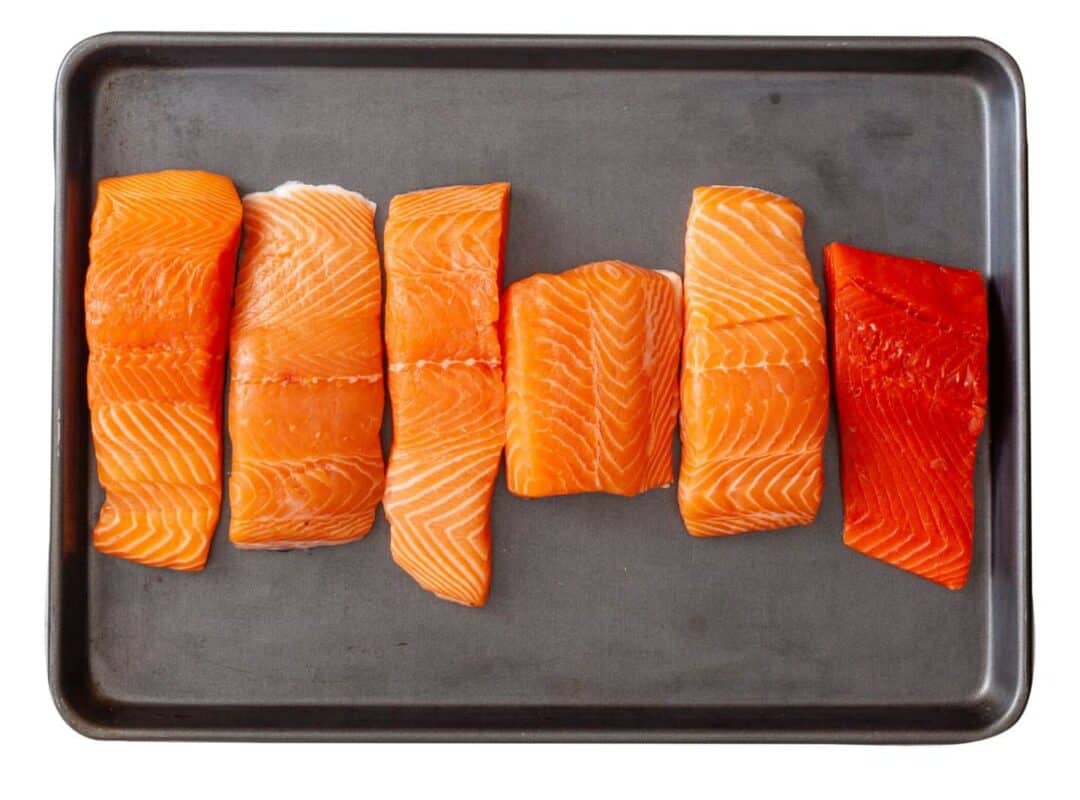
Get into a highly regarded fish market which safely handles salmon
You have to locate a store that handles the fish well in order for the salmon to be healthy and secure to consume whole. See how the fish fillets are seen in the aluminum tray surrounded by many other crushed ice. On the other side, whole salmon can be fully buried in the freezer.
- Salmon fillets can be arranged to strike the flesh as least as practicable of other fillets.
- The shop workers can cut fresh salmon fillets to customers in full display. Make sure that cutting boards have always been regularly washed and sanitized.
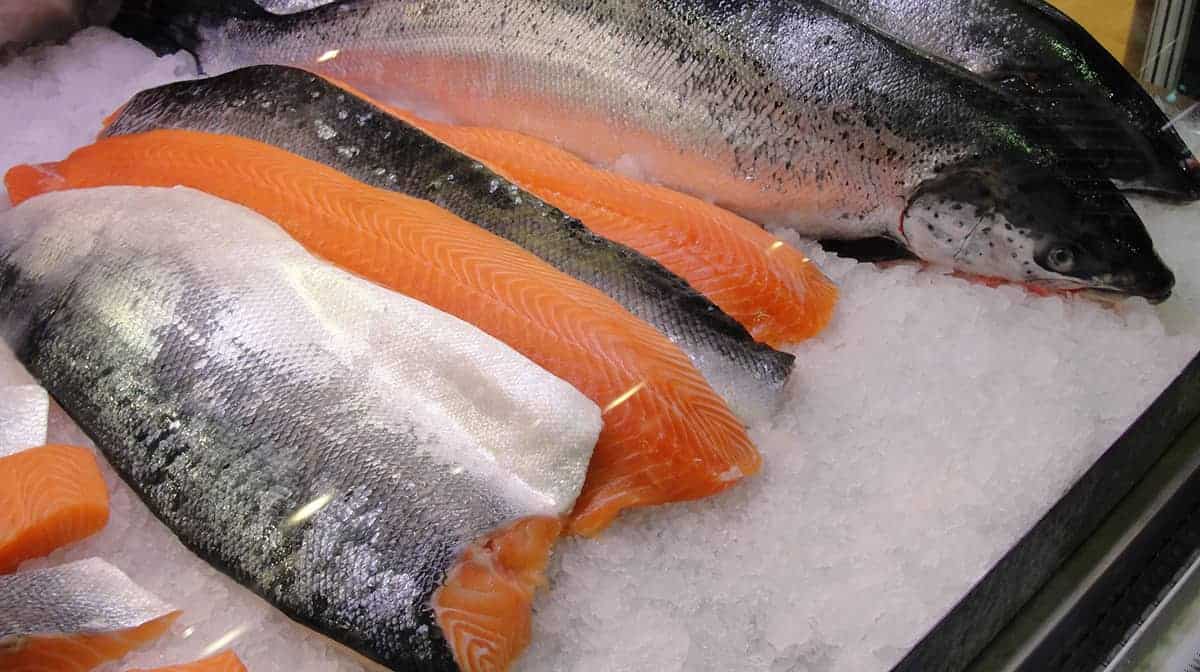
Select farmed salmon to prevent parasites
To make sure that the sushi have no parasites, it is safest to avoid having wild salmon. Farmed salmon often are fed free of parasites, then you can be confident that your fish are healthy. Farming salmon is normally branded as such, but answer a seafood market worker if it really comes from a farmer or a wild farmer, if you’re not positive.
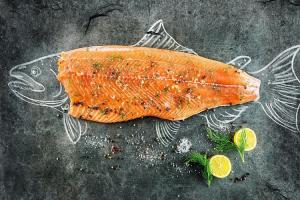
Purchase entire salmon to find freshness easy to determine
Though salmon fillets become simpler to handle, freshness of whole salmon is normally more noticeable. If you prefer entire salmon, you have to choose the freshest fish.
To research freshness of the salmon’s eyes and flesh
No products found.
Make sure that the gill of the fish is red, the eyes seem clear and blurred and the meat is smooth and strong with the entire salmon. Look for vivid pink and sometimes orange flesh and the fine white lines that travel along it with salmon fillets.
- Clean marine scent or tight muscles are also needed for whole salmon.
- If the eyes of a whole salmon are blurry or sunken, it is probably not young. Another indication that salmon may also be poor is a milky coating on the outside of the fish.
- When the fillets of salmon are dull gray either yellowish, perhaps they went wrong.
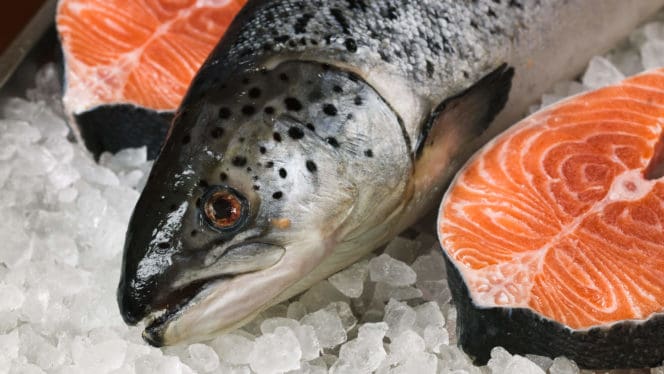
Scale and intestine salmon to be healthier for yourself
Scaling or gutting could be a lot of hard work, particularly when you’re not used to it so you might want to clean your own fish if you are uncertain about how clean and respectable the market is. A fish scaler, a fish tweezer and the best knives are needed to do the job.
- If yourself purifies and intestines the fish, make sure that all blood or guts are washed with clean water from the fish.
- If you trust the market for food, it’s helpful to ask how to clean up the fish and to gut the fish.
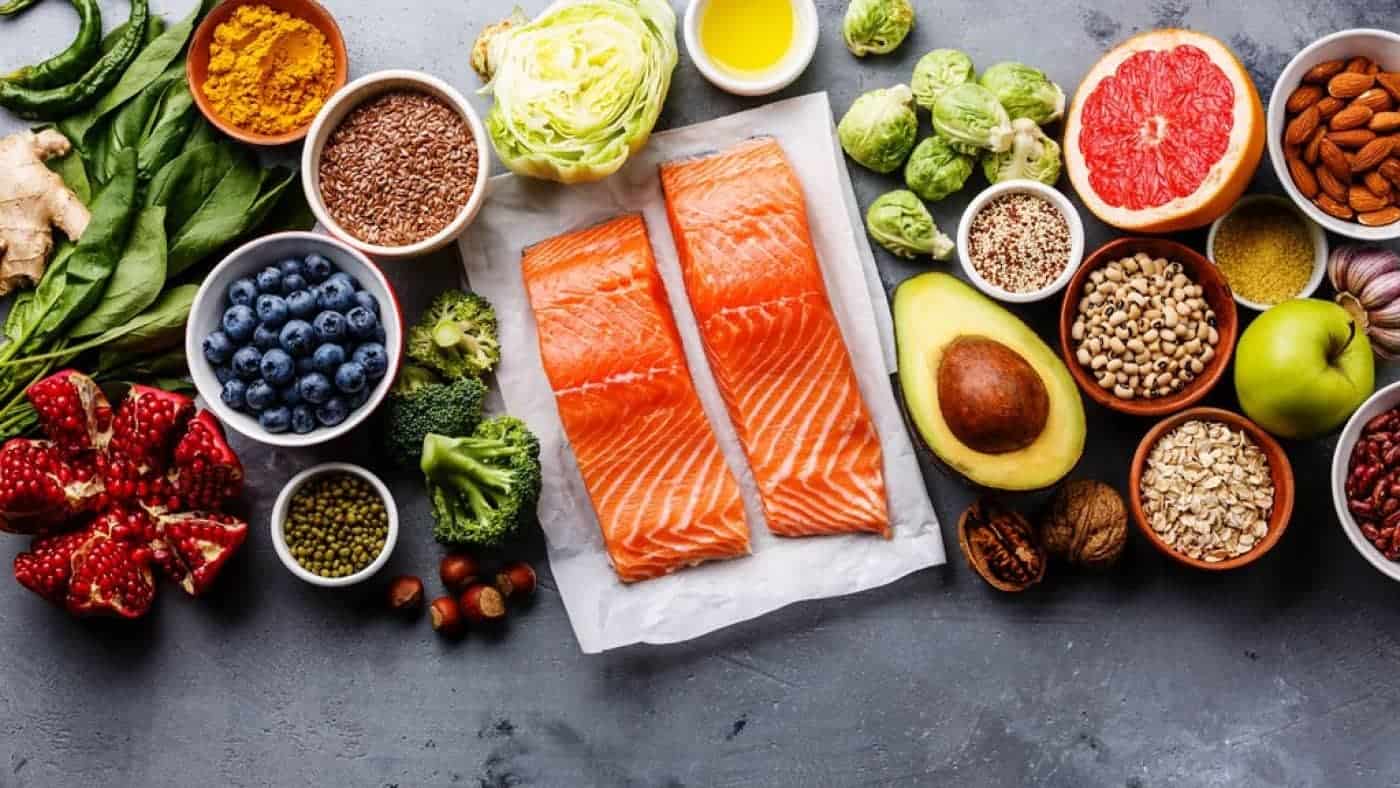
How To Prepare Tools And Kitchen Space
Sanitize a cleaner product on the work surface
It is necessary to make sure that your workplace is not polluted or placed with germs until you start to fillet or cut the salmon. Wipe the counter and cutting board down with a 1 cubic meter (15 ml) solution of bleach dissolved into a cup of water. Enable that solution to rest 30 seconds also on the surface before drying.
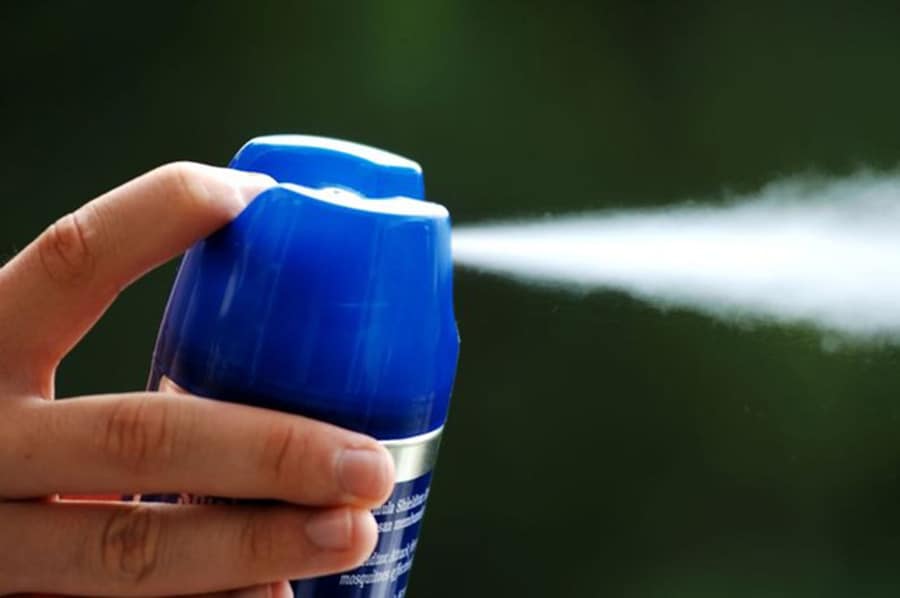
Disinfect the knives with some bleach
You’ll need to have a filet knife as well as a butcher knife to cut the salmon. Sanitize the cloves with cold water, fill a spray bottle and then cut its spray nozzle. Dip it in bleach about three-quarters, add it to the container, then shake well in order to blend bleach with liquids. Repeat the procedure two more times and use the solvent to spray the knives. Let it rest 10 minutes on the blades.
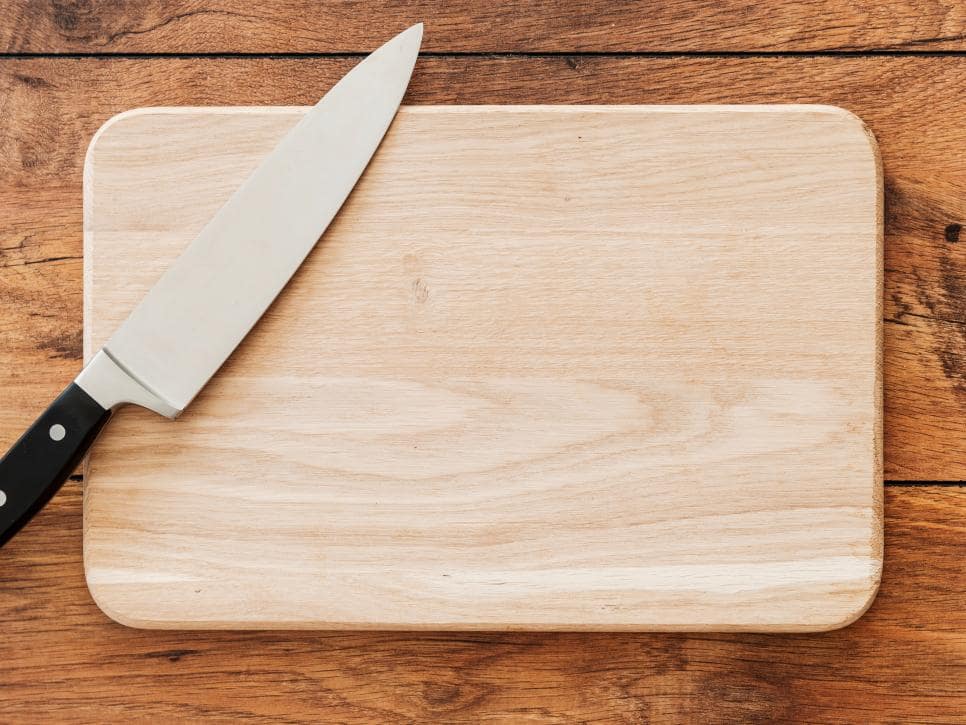
Clean the hands and knives
No products found.
Using warm water as the antibacterial dishes cleaner to disinfect them after the knives are sanitized. When you’re finished, dry the instruments well with a clean towel. Clean your hands using antibacterial soap and rinse them when handling the salmon, and also the last stage of your planning. It’s a smart idea to use disposable cuisine gloves when you’re handling salmon to guarantee that both hands remain safe.

Thoroughly dry the fish
To prevent germs from growing on your working surface, which helps to clear some extra humidity from your salmon until it is filleted. Choose a clean dish towel and towels to blow the fish.
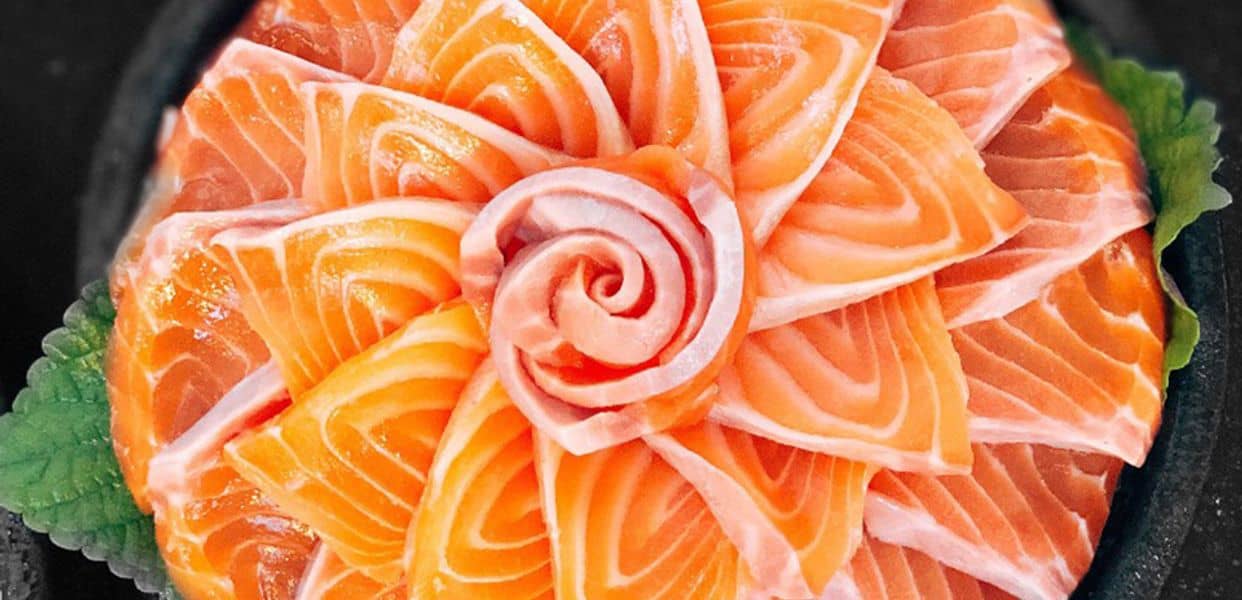
How to use a knife
You possibly believe it doesn’t matter, but shockingly, how you carry your knife. Trust us as we claim that paying close attention to the knife is a first move in cutting sushi like a pro.
Somebody have a handle on their kitchen knife. While this is not wrong, consider using the finger and thumb to grip the blade base to increase the precision and durability of your cuts. It will sound a little hard to do, but after you hang up, you can show yourself the difference. You would have better influence and over angle as well as quality of the slices.
Be careful, moreover, when placing your cutting paw. The slicing hand corresponds to the hand used to catch the salmon. When you catch tuna, your fingers can curl inside and shape a claw.
You should also use your thumb to prevent the work surface from rising while your slice into the tuna, as well as curling inside. You would still get the middle finger perpendicular mostly to the cutting panel. This stops you from unintentionally cutting yourself.
Another tip from the specialists: Ensure that the knife’s tip is below the core of the finger to discourage slashing. You need a best knives sharpener if you really want your sushi cut to be precise and delicate.
How To Filleting The Salmon Whole
The next move is to purify the fish. You must cut out any extra fat or fillet bloodlines. Kitchen tweeters may also be used to extract pin pieces from the salmon. Expect to feel the fillet’s length with the finger to reach its pin bones.
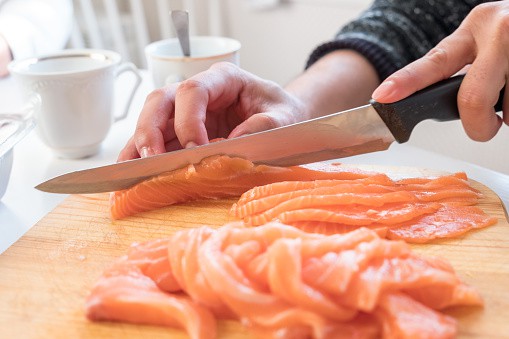
Place the salmon on your back and see the spine
Place fish at the edge of the work surface on the smooth, cleaned cutting board and table. Take a wide butcher knife and bring it right behind it’s head into the salmon. Break the spine from a sawlike movement in and out before you remove it to the ends of the salmon.
- Tilt the knife gently into the back so that you can get as much salmon meat as possible.
- While you chop, it helps remove the shoulder of belly meat. This helps make it a little simpler to see around the spine since it allows you more control and leverage.
Delete its first fillet then reserve
You would get the first fillet as you cut the whole way into the salmon. Place it on a clear, sanitized plate on the sides for the moment.
Flip over the salmon and repeat it
Turn the salom over to face the belly also with the head to the right. Cut the next fillet just like you did that first one see the knife down the back of your head.
- When done, two fillets would be cut, the spine with virtually all beef, as well as the carcass with either the head and the fins.
Remove the carcass
You have head, tails, fins and spine until you stop cutting the fillets. You may either give them away or save them to store fish.
Remove the fillets from the ribs
Even use a fillet knife that gently split each fillet from the ribbons to the beef. Hold the knife as near as possible to the ribs so that you can not cut more fish than required.
To be sure all of the ribs are gone, brush your fingertips over the salmon to see whether you could feel anything that you skipped. You may even scratch the knife to look for broken ribs along the cod.
Trim some fat
Using the knife to extract the fat from the fillets until the ribs become separated. You will normally notice it around the abdomen and in the fine regions.
Through pliers remove any remaining bones
There will always be bones throughout the filets as you fillet the salmon. Use a nose pin pair to take them out. Run the thumb over the bone end points and softly leave the thumb to pull them out of the pins.
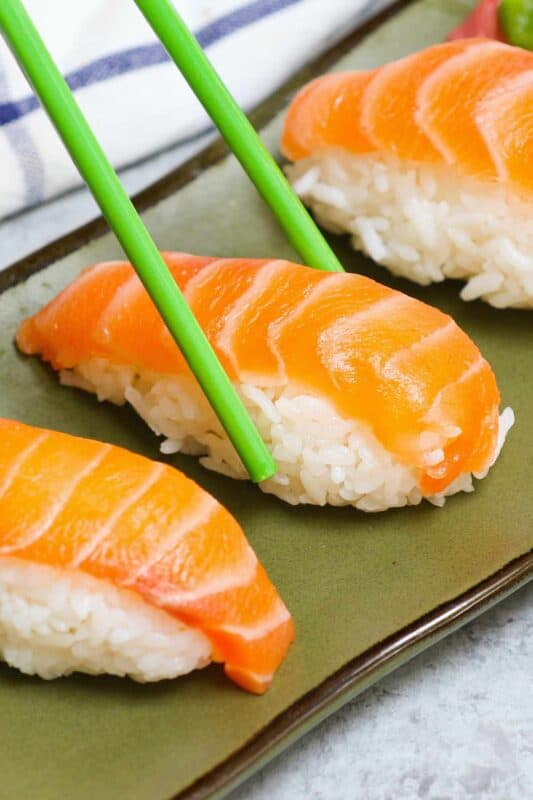
NOTE:
The salmon fillet starts both with the sashimi and the nigiri. It is best to use a whole fillet of salmon if you make either in bulk. Here are a few guidelines if you are uncertain how to cut a salmon for sushi. You might purchase a smaller chunk of salmon fillets which would cost less if you don’t make that many. They also come sealed and filleted or skinned with vacuum. Works anyway. It depends just as to how much will try to do.
What portion is used for sashimi or what part is used for nigiri? Recognize white line down its fillet center? To break the fillet, erase it white line. This section of the salmon is harder and does n’t have the similar feel as the majority of its fillet.
Note: Whether you don’t feed an army or even have a restaurant, we can see that some make both sashimi or nigiri from any portion of the fillet. That’s not the best method of splitting the fillet, and the most efficient usage of salmon if a whole fillet is used.
How To Cut Salmon For Sushi Step By Step
Nigiri is sliced to sashimi similarly, with a few slight exceptions. First, since we apply rice to it, we want to cut it a little thinner. Because you are now chopping upon this belly side of a salmon fillet, you’ll need to remove the grain of its at an angle of about 45 degrees.
The first element is like breaking the fillet’s corner. Do not let this piece be a waste, but neither can it suit the other nigiri. In a movement back and forth, the salmon can just break up and spoil the show. Before chopping, please ensure you get a sharp knife.
After the previously cut, do it with the rest of the fillet making clean, small, standardized slices throughout.
Related to our above remarks, sashimi or nigiri won’t always be made out of the salmon filets. Turn the salmon 90 degrees, and split the nigiri in good thin strips, still against grain, as seen below.
And it’s easy for the appearance of the nigiri. Dampen the hand and take some rice sushi. Ball it in a football form and put it over the top like that. The appearance is all, like all sushi or sashimi dishes.
Break the salmon in line with the sushi
If you have fileted the salmon, you will also have to slice it according to the kind of sushi you make. Follow the sushi recipe and figure out how to end it.
You may start with this move if you have purchased salmon fillets.
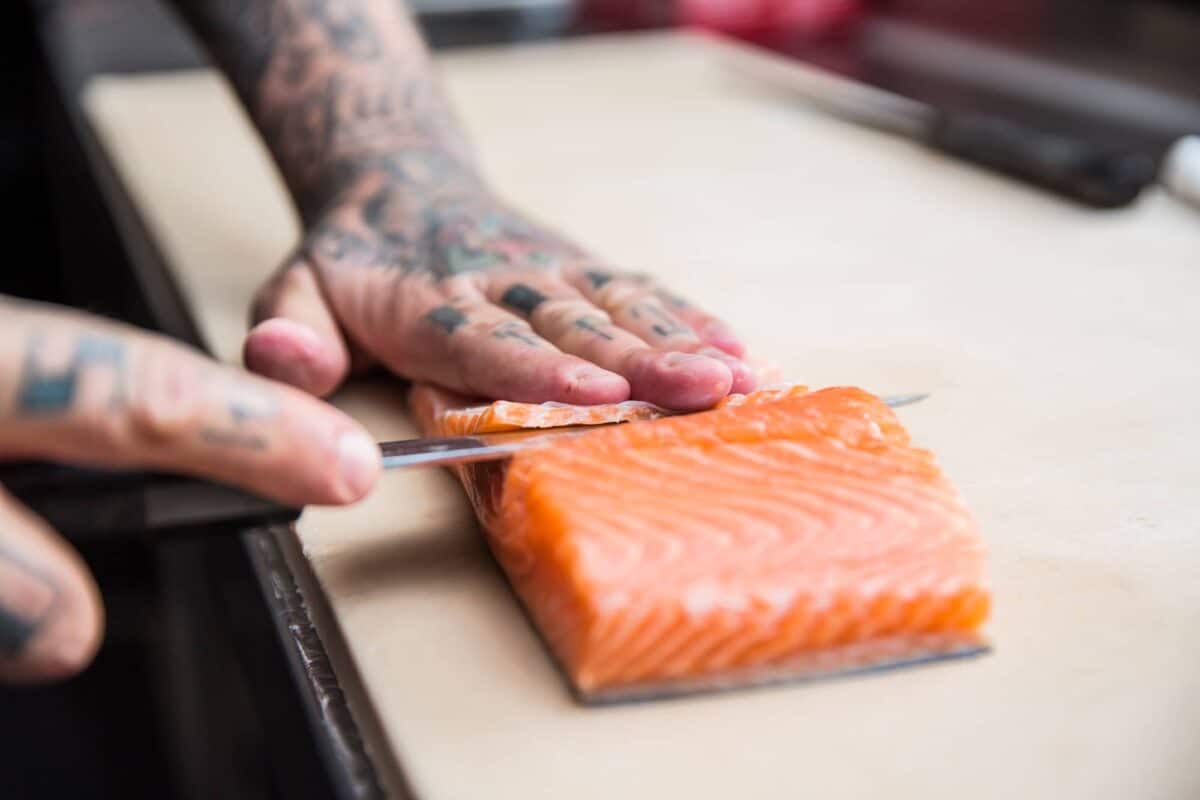
How to cut salmon for sushi
Keep the knife also at the end of its fillet at a 45 degrees. To break a small fragment, use an only one, smooth motion; prevent the use of a sawing action. Slices can have a thickness of around 1 ⁄ 8 inch ( 3,2 mm ). Keep slicing until the whole fillet is over.
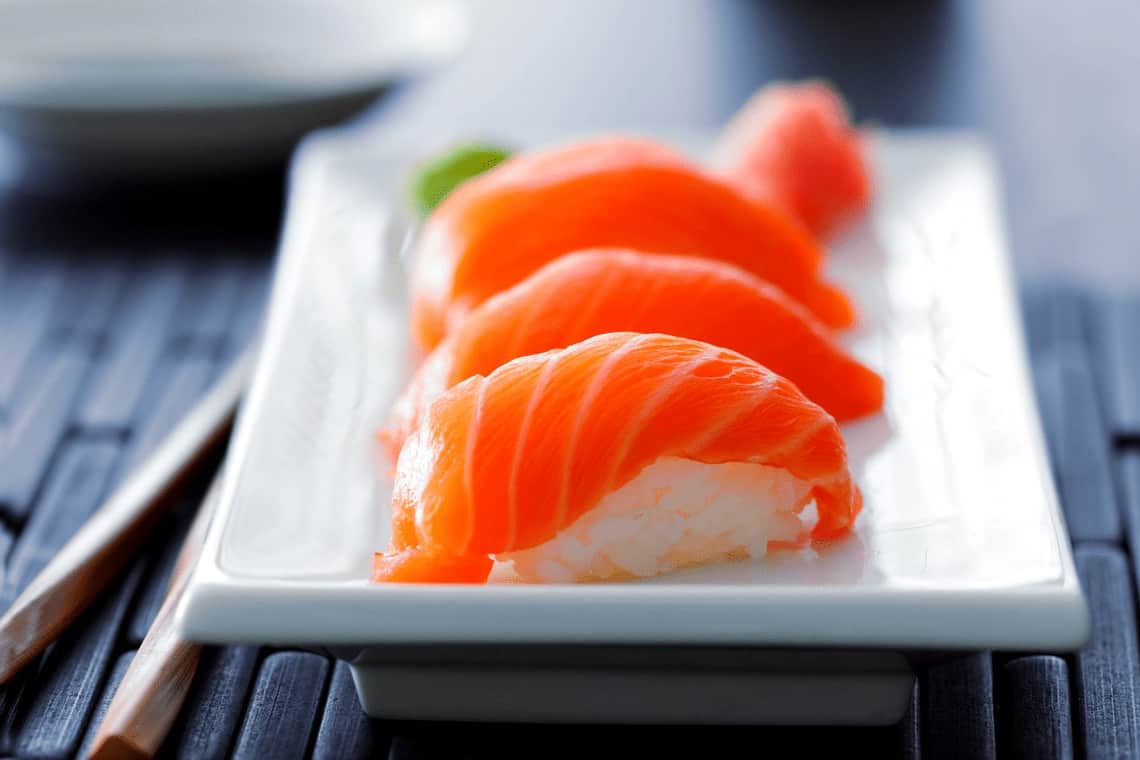
How to cut salmon sashimi
Start cutting each fillet into strips of 1 inch ( 2,5 cm). Then dice the streaks in around 3 ⁄ 4 inch ( 19 mm ). Continue to cut until you have filled the whole fillet.
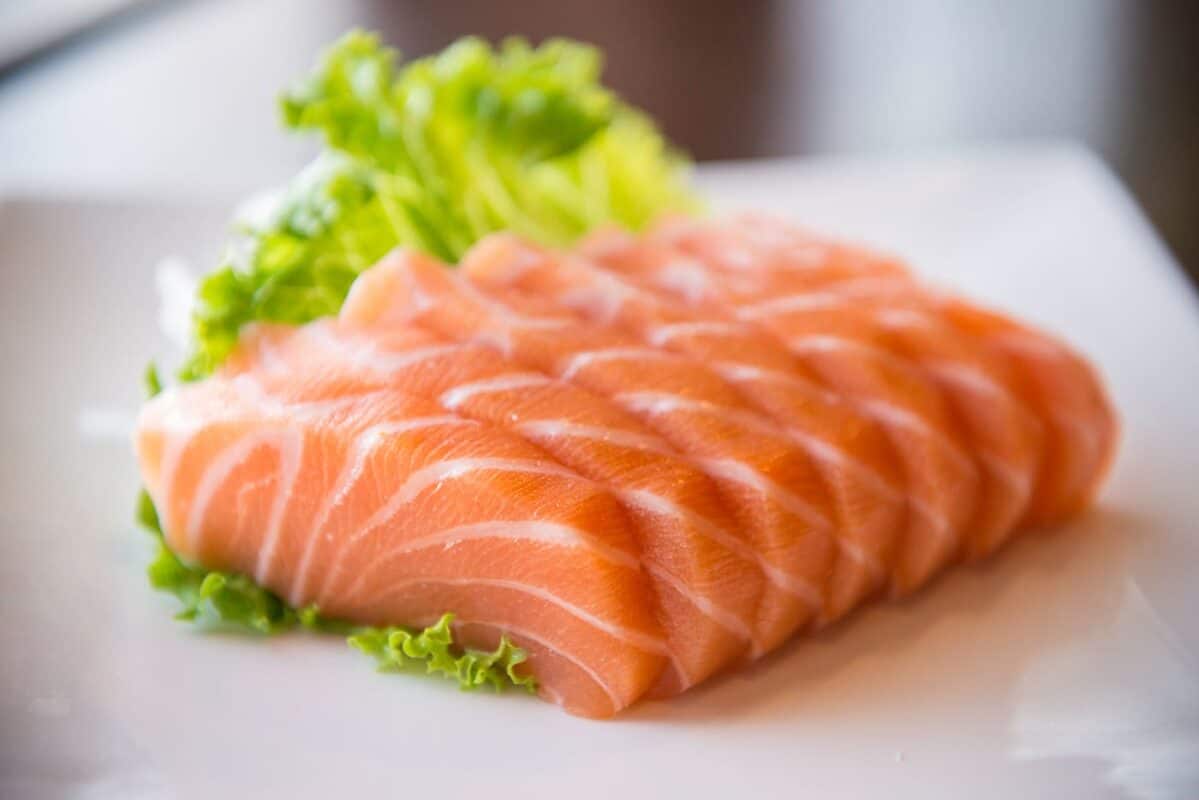
Cut long salmon bits for sushi rolls
You typically want thin, long pieces of salmon for the rolls. Cut the fillet across half and parallel the long side of the piece on which you deal. Slice that salmon into a piece about 1 ⁄ 2 inch ( 1,3 cm ) wide. Keep slicing before you have ample rolls of salmon.
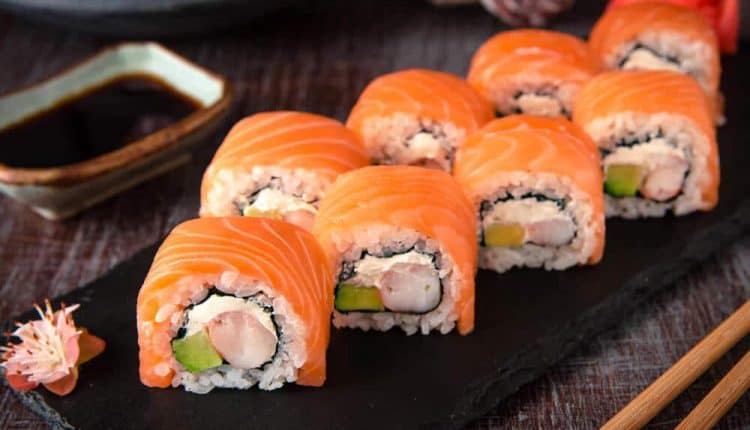
How To Make Salmon Sushi
Here are some simple steps to make salmon sushi:
Cook sushi rice
The finest nigiri salmon begins with the best sushi rice. The greatest work is Japanese short grain sushi rice. After the rice has been prepared, move to a big bowl then let it cool down. Condition using sushi vinegar when it’s still very high.
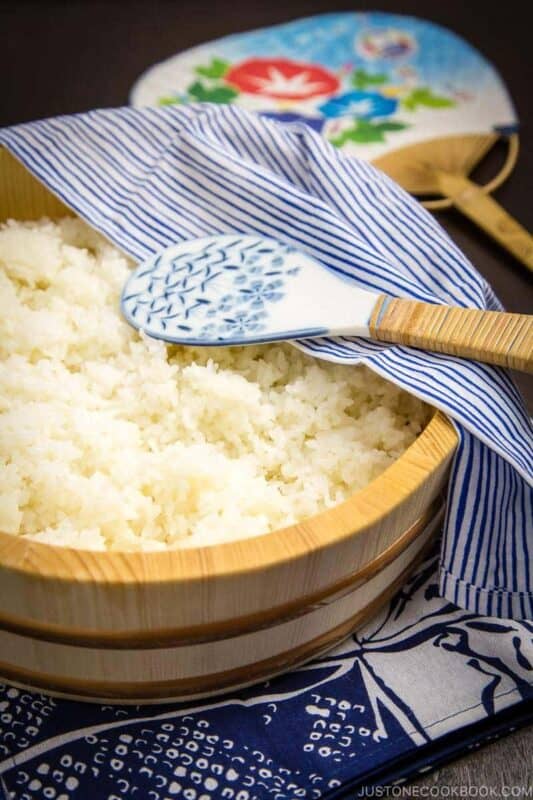
Slice Salmon
Slice the salmon against grain at an angle of about 30 – 45 degrees. You must change the angle periodically to get the correct length or thickness. I propose to break it to bits that are 3 inch long, 1 / 4 inch thick and 1 inch wide.
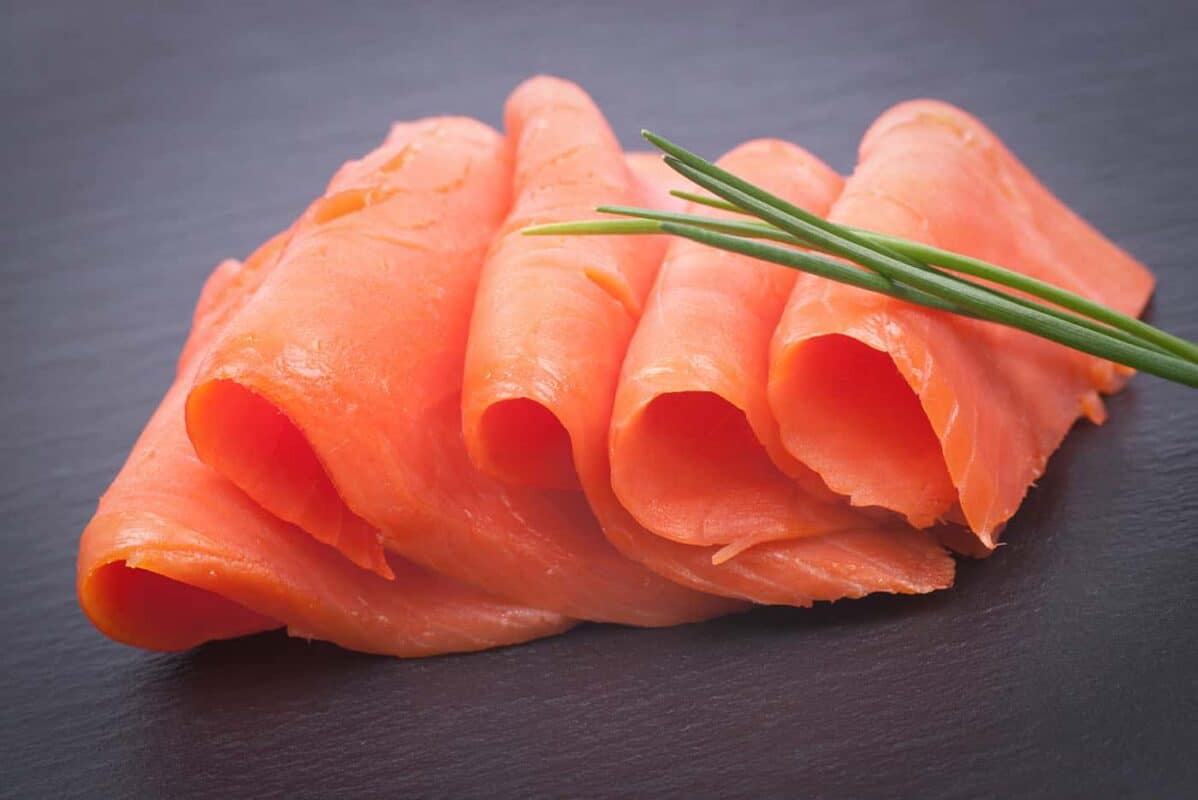
Format the rice
Take in your right hand around three tablespoons of rice. Squeeze it into a tight oval shape until it is rolling. Aim to flat the field with both a rounded end.

Apply wasabi with salmon
place the root of the fingers in a slice of salmon. Then take a small portion with wasabi in pea size and scatter it among the fish. That’s an optional move, and if you don’t have wasabi, you could skip it.
Assemble the sushi
Put the rolled rice onto each salmon and bend the fingers together to cover both fish and rice. Press down its rice on the other side with the index finger.
Arrange then serve
Turn fish and rice, and leave the slice of salmon on the top of its rice Arrange on a plate and serve along with pickled ginger with the optional soy sauce, wasabi.
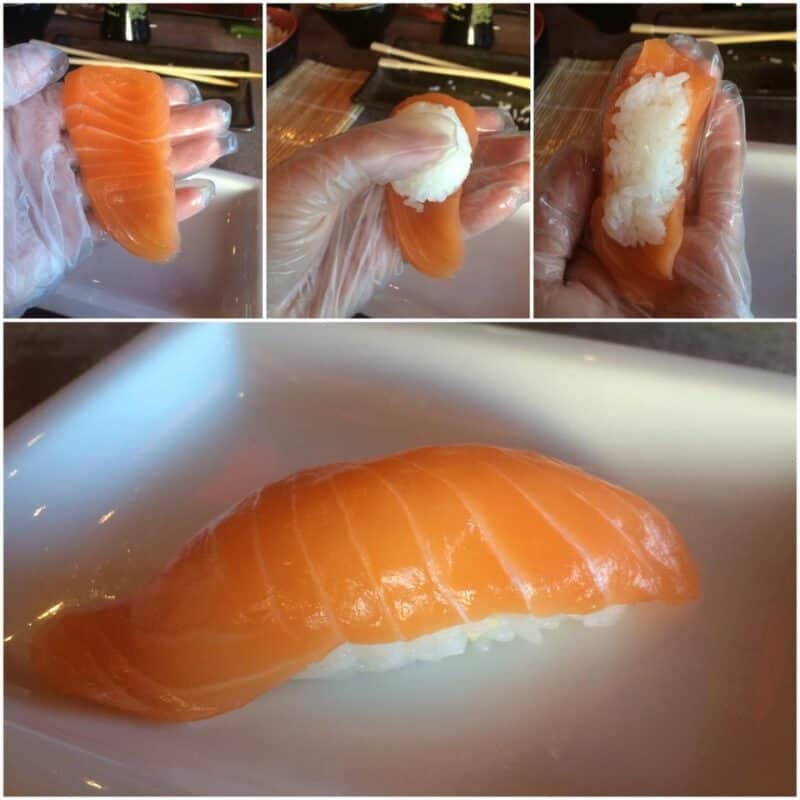
TIPS and TRICKS
For this meal, use Japanese high quality short grain sushi rice. You need to apply less water even than normal rice cooking. I propose a 1 : 1 ratio from rice to water that doesn’t make the rice mushy when it is squeezed.
For safety concerns, select sashimi grade salmon. And break it into the right size for nigiri against the grain. It won’t have the proper form on the surface of the rice if the salmon becomes too dense, but it will drop the taste if it is too small. The strongest thickness is approximately 1 / 4 inch.
Tezu, a hand dipped liquid created from water with vinegar, may be made for preventing rice sticking to the palms. Until handling rice, wet the hands with Tezu.
Squeeze the rice tightly, just don’t squeeze too tightly. It can always have some air throughout the rice.
What Are The Health Benefits Of Salmon
Salmon is protein packed
Salmon has plenty of nutritional protein. The fat content of fish comprises about 25 grams including dietary protein each 100 grams.
In addition, salmon contains full protein. This ensures that perhaps the fish includes in the correct dosage all nine basic amino acids.
Raw fish are very rich in protein that fosters muscle growth as well as energy.
Protein is important for a variety of human functions, including helping the body rebound from damage, muscle mass conservation and bone health protection.
It is an omega 3 high source of fatty acids
Oily fish are a great source of fatty acids from omega-3. Such fatty acids perform a substantial role in the human body’s general well-being.
Many tests have also shown that eating large levels of fatty fish improves cardiovascular wellbeing. Thus fatty salmon sashimi cuts have huge quantities of omega 3 fatty acids.
Raw Salmon becomes vitamin B packed
If you are searching for better B vitamin sources, raw salmon seems to be the perfect pick. The part size about 3,5 ounces is composed of the appropriate B vitamins:
Reference Daily intake (RDI)
18 percent of RDI is Vitamin B1
29 percent of RDI is Vitamin B2
50 percent of RDI is Vitamin B3
19 percent of RDI is Vitamin B5
47 percent of RDI is Vitamin B6
7 percent of RDI is Vitamin B9
51 percent of RDI is Vitamin B12
The above vitamins are vital for many essential body functions, including the production and repair of DNA, transformation of meat into energy and reducing heart disease inflammation.
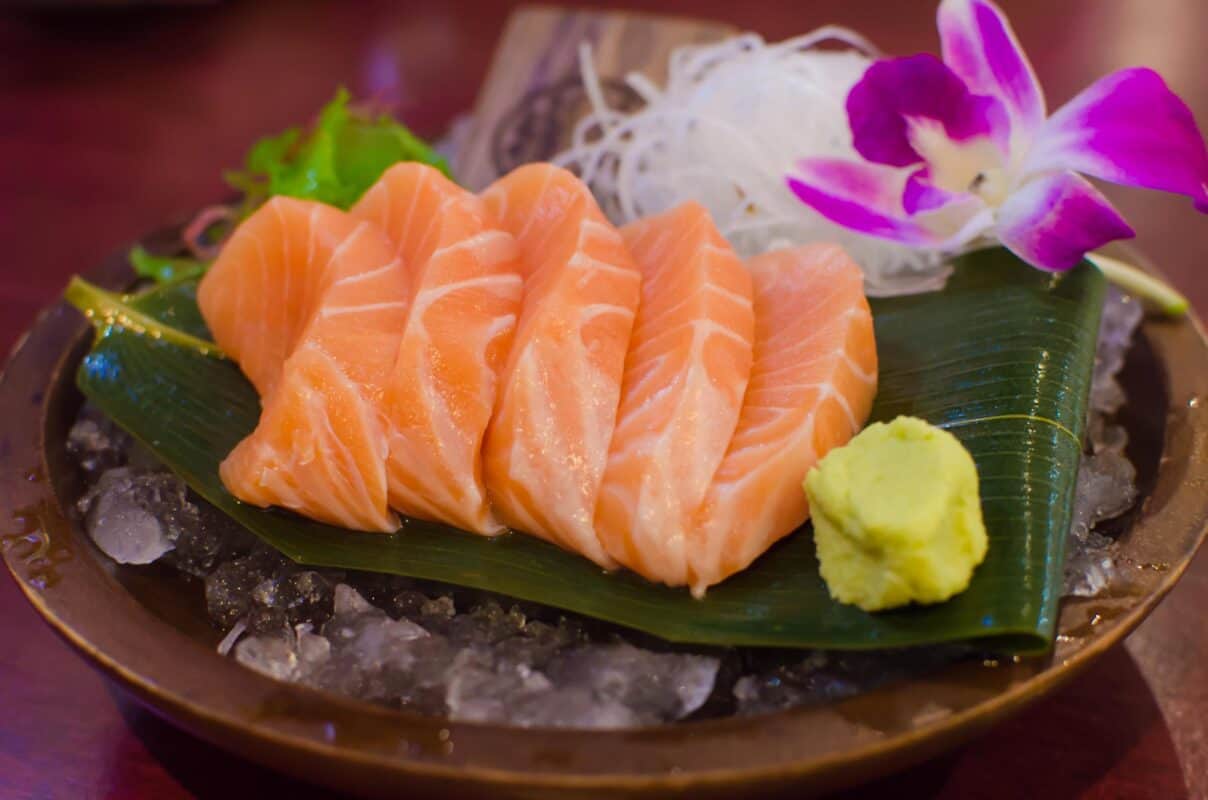
Salmon is potassium loaded
When people think of potassium people thinks of bananas, however Salmon is also a decent source of potassium. Particularly raised ocean, ocean-loved salmon! In reality, Salmon absorbs more potassium than the same value of banana served!
Controlling blood pressure or reducing possible risk of the stroke, potassium is critical. A systematic review of 30+ trials shows a substantial decrease of blood pressure by potassium supplementation.
Salmon Sashimi Is a Strong Selenium Source
Selenium is present in soil and certain foodstuffs are also present. Our body only needs this mineral trace in a small quantity. It is necessary to get enough of it by diet.
Selenium is also considered to protect bone health and it may help lower the risk against cancer. It also lowers thyroid antibodies among autoimmune thyroid patients.
The use of high salmon sushi, such as sashimi, will also increase blood in people who drink fewer selenium otherwise.
It helps to manage weight
The consumption of salmon will help with weight loss and keep your body balanced. The salmon also tends to suppress hunger hormones and therefore can keep you feeling whole.
Protein rich salmon consumption raises the metabolic rate as well as omega 3 fatty acids can reduce belly fat among overweight people.
The addition in children with a non alcoholic DHA fatty liver disorder contributes to a considerable decrease of belly fat or liver fat.
Q&A Part
What is a Nigiri?
Nigiri is a kind of sushi, with thin fish slices or even other proteins such as fried eggs above pressed rice.
Sashimi Vs. Nigiri: What’s the distinction?
There’s not a variation except they are also finely cut raw meat dishes from the Japanese society. Even so, they are somewhat different. Sashimi is not as slim as nigiri and is served alone or sauce garnished, most common is wasabi or soy. Nigiri, on either side, is not consumed alone. It is often followed by a sushi rice ball.
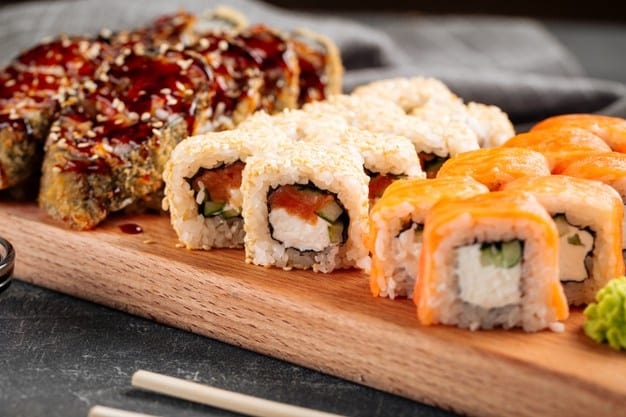
How many calories in salmon sushi?
In one slice of salmon nigiri there are approximately 64 calories.
Are Raw Salmon Frozen Healthy to Eat?
Yeah, much of the popular sushi you consume in sushi bars include fish frozen until they are used. You don’t fall on your plate new from the sea or from the sea. While frozen, the salmon still tastes great and are far cheaper than the fresh fish.
Fresh fish are stored directly after being harvested at or below -20°C to maintain them healthy for raw consumption. When you visit wholesale fish dealers, ask them to send you the high quality sushi grade fish, grade 1.
What is the best salmon freezing temperature?
Fresh fish are captured and frozen at such a range of -20 °F to -31 °F. It is hard to hold the temperature at home in the freezer so you quickly eat crude fish. There are mega freezers in some sushi bars, which will hold salmon frozen at -60°F.
The Food and Drug Administration (FDA) advises that fresh fish used for dishes such as sushi, ceviche and tartare be freezed for a minimum of 7 days or for a minimum of 15 hours at -31°F at -4 °F. You can refer to the best commercial refrigerator brands that can preserve good fish
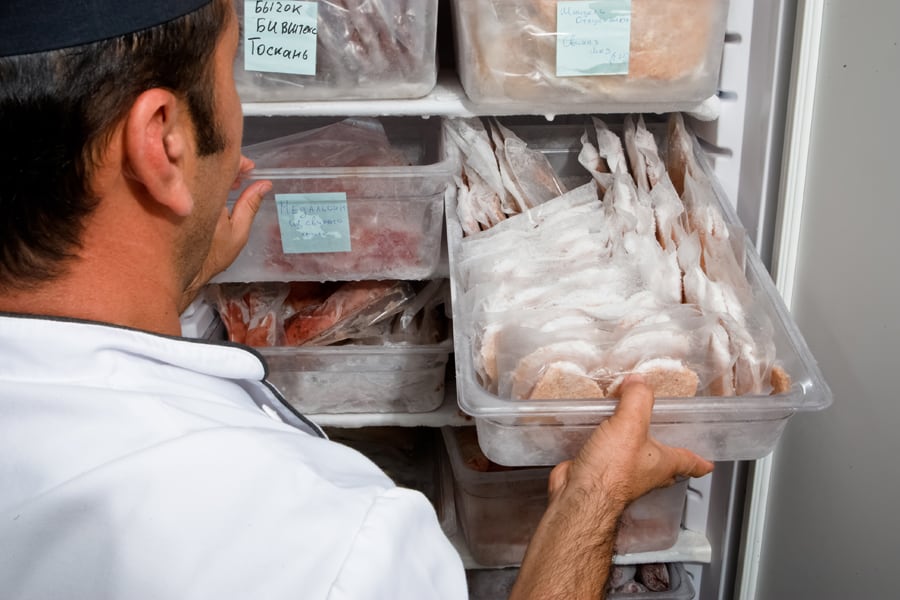
How to know whether or not salmon is fresh:
Smell: Give your nose a slice. Smells it natural – fishy and salty? Does this really smell strange? Avoid that!
Appearance: Fresh salmon looks brilliant with a gem-like style.
Color: It’s nice to go as well as the colour scheme of the fish is vibrant.
Shape: Poke this! Shape: Poke it! Is it back to its original condition? If so, it is a strong, fresh slice of seafood.
As you’ve seen, salmon changes your food consumption and optimal health totally. Daily incorporation will have a profound effect on the body.
Conclusion
Essentially, it might seem very complicated how to cut salmon for sushi as well as how to cut sashimi salmon, but everyone can do it with proper instructions and daily practice. You hopefully realize already that the seafood style you are using for food, the knife to be sliced as well as the way you handle the knife all contribute to the precise and precise cutting of your salmon.
Your turn is now to shoot it, so sharpen the knives and try your abilities.
| Read Also: Top 17 Best Skillets For Glass Top Stoves: Supportive Cooking Friends For Every Household 15 Best Scissor Sharpeners That Save You Tons Of Time and Money |
G Patel has been honing his craft in the restaurant industry for over 25 years. After graduating from North Carolina State University with a degree in business, G set out to turn Eschelon Hospitality into a recognized brand throughout Carolina’s state restaurants; and he did just that when acquiring Mura North Hills. Since then, it has become an iconic sushi-serving establishment.

